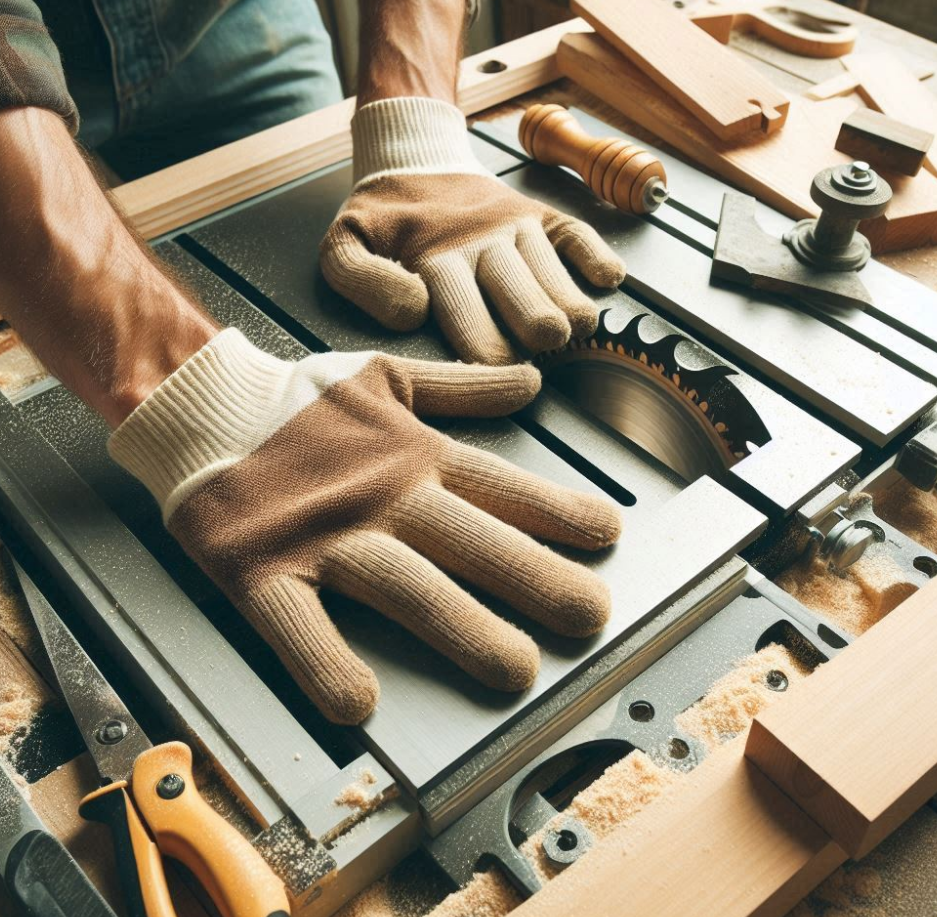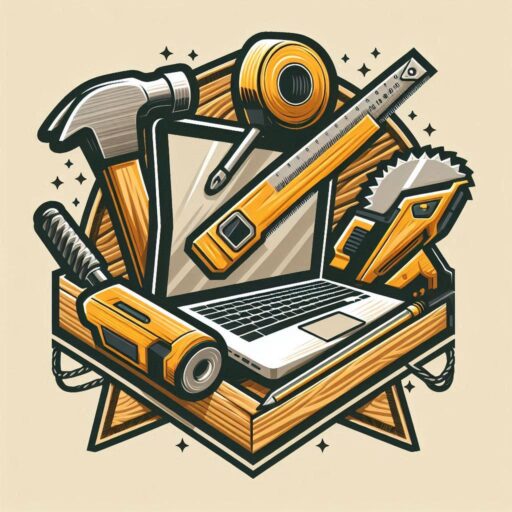 Table saws are at the heart of any woodworking project. They’re the mainstay that transforms raw materials into crafted pieces of art or utility. Without them, precision cutting would be near impossible, making the whole woodworking process inefficient and frustrating.
Table saws are at the heart of any woodworking project. They’re the mainstay that transforms raw materials into crafted pieces of art or utility. Without them, precision cutting would be near impossible, making the whole woodworking process inefficient and frustrating.
Understanding the basics of a table saw starts with knowing its key parts: the tabletop, blade, and safety features. These are not just components, but the pillars that uphold your work’s quality and your safety. The tabletop ensures a steady place for material handling, the blade slices through with exactness, and safety elements keep mishaps at bay.
This article aims to provide a comprehensive guide to navigating table saw woodworking safely and effectively. Whether you’re new to the craft or seasoned in your skills, the insights shared here can help you work smarter and safer.
Understanding the Anatomy of a Table Saw
Breaking down a table saw into its components can make the tool less intimidating and more manageable for any woodworker. The table saw consists of several essential parts, each playing a pivotal role in both performance and safety.
The tabletop is your workspace. It’s where the magic begins, providing a stable surface for your materials as you cut. It needs to be smooth and clutter-free to ensure a straight and precise cut every time. Regularly cleaning and maintaining the tabletop ensures it functions effectively, reducing errors in your work.
Next, there’s the blade, the star of the show. This component does the actual cutting, and its sharpness and quality are crucial for smooth operations. Choosing the right blade type for your project can significantly impact your results. Keep it sharp, and replace it when it shows signs of wear.
The throat plate covers the hole through which the blade emerges. This piece helps prevent wood pieces from falling into the machine and doubles as a safeguard against unwelcome debris that could affect the blade’s movement. Ensuring it’s secure in place is part of your safety check routine.
Maximizing Efficiency with the Tabletop
The tabletop is more than just a flat surface; it’s the foundation for precise cuts and seamless workflow. When it comes to optimizing the tabletop’s function, keeping it in prime condition is key.
A clean tabletop can make all the difference in your cutting accuracy. Dust, debris, or any inconsistency on the surface can interfere with the path of the wood, leading to jagged cuts and wasted material. Make a habit of wiping it down after each session to prevent build-up.
Flatness and stability are also crucial. If the tabletop wobbles or isn’t level, your cuts won’t be either. Regularly check for any signs of wear or damage, and repair or replace parts as necessary to maintain a sturdy base.
For those who want to step up their game, consider a tabletop upgrade. Higher-quality materials can provide smoother surfaces, increasing the precision of your projects. This can be particularly beneficial for intricate cuts where detail is paramount.
If you’re dealing with large pieces of wood, extensions or outfeed tables can be lifesavers, providing additional support to prevent tipping and handling accidents. With these in place, you can tackle more extensive projects with ease and confidence.
Choosing the Right Blade and Throat Plate
A well-chosen blade is integral to the performance of your table saw. Different blades serve different purposes, and picking the right one is essential for achieving the desired cut. For instance, a rip blade with fewer teeth works wonders on wood grain cuts, while a crosscut blade makes finer cuts across the grain.
The sharpness of the blade is equally important. Dull blades not only make cutting laborious but also pose safety risks, increasing the chances of kickback. Always check the blade’s condition before starting your work, and sharpen or replace it as needed.
Throat plates, though often overlooked, play a crucial role in maintaining smooth cutting operations. They act as a barrier, preventing small offcuts from falling into the saw and causing jams or interference with the blade’s rotation. Using zero-clearance throat plates can enhance precision by reducing the gap between the blade and the plate, especially useful for delicate cuts.
Changing out blades and throat plates requires care. Always ensure the saw is powered down and unplugged before making any swaps. Familiarize yourself with the locking mechanisms and the specific procedures outlined in your table saw’s manual for safe and correct installation.
Investing time in selecting the right blade and throat plate not only improves your work quality but also extends the life of your table saw, making every project smoother and more efficient.
Getting to Know the Arbor and Its Importance
The arbor in a table saw is often considered the backbone of the cutting mechanism. It’s the spindle responsible for holding the blade firmly in place while allowing it to spin at high speeds. Understanding its role helps you appreciate how critical it is to achieving consistent and precise cuts.
A well-maintained arbor ensures that your blade runs true without wobbling, which can lead to inaccurate cuts or, worse, hazardous situations. Check regularly for any unusual noise or vibration, as these could indicate an issue with the arbor or the bearings supporting it.
Routine maintenance of the arbor might involve cleaning and lubricating it to prevent rust or seizure, especially if you frequently work in a high-humidity environment. Consult your saw’s manual for specific instructions on care and lubrication schedules.
It’s also wise to inspect the arbor nut regularly, ensuring it’s tightly secured. A loose nut can lead to a disaster mid-cut. Use the right tools to achieve the proper torque, keeping safety your top priority as you work.
If your work involves frequent blade changes, practice careful handling during installation and removal. Misalignments during these processes can affect arbor performance and shorten its lifespan, so take your time to do it right.
Fence and Miter Gauge: Essential Guides
The fence and miter gauge are your best allies when it comes to achieving straight and accurate cuts. These guiding components ensure that your material is fed through the blade at the precise angle and distance you require, making them indispensable when precision is paramount.
A reliable fence should lock securely into place, providing a stable guide that won’t budge under pressure. Make it a habit to check the alignment before each use. Even a slight deviation can result in cuts that are off, wasting material and time.
Calibration of the fence is crucial as well. Follow your saw’s specific instructions to ensure the fence is parallel to the blade, minimizing the risk of binding or kickback. Many woodworkers find that investing in an aftermarket fence system can improve accuracy significantly.
The miter gauge, on the other hand, is used for angled cuts. It’s vital for miter and crosscuts where accurate angles can mean the difference between a project’s success or failure. Regularly check that your miter gauge is calibrated to common angles and doesn’t have excess play or movement.
For enhanced versatility, consider custom jigs or auxiliary fences that attach to your miter gauge. These can offer additional stability for wide or awkwardly shaped pieces, helping you handle more complex projects with confidence.
Taking the time to understand and configure your table saw’s fence and miter gauge can exponentially increase both the quality and safety of your cuts, allowing you to work more efficiently and with greater peace of mind.
Elevation and Tilt: Fine-Tuning Your Tool
Elevation and tilt controls on a table saw allow you to adjust the blade’s height and angle, providing versatility in your cuts. Mastering these settings can open up a world of possibilities in terms of project complexity and precision.
The blade height is your primary control for cut depth. Whether you’re making shallow grooves or shearing through thick lumber, having the ability to fine-tune this elevation ensures that each piece fits precisely into your overall design. Always remember to adjust the blade height while the saw is off, ensuring safety as your top priority.
Likewise, the tilt mechanism lets you set the blade at an angle, ideal for beveled edges and mitered joints. For craftsmanship that holds up under scrutiny, make sure your blade angle is set accurately. Verify the correctness of your angle against a protractor or a digital angle gauge to ensure finer detail work is on point.
Practice adjusting these controls even when you’re not actively cutting. Familiarity with the mechanisms and their responsiveness under different loads can prevent errors when accuracy is paramount in your real projects.
Finally, always return the blade to a neutral position when your project is finished. This not only prolongs the life of the adjustment mechanisms but also prepares your saw for the next set of cuts when you need it again.
Empowering Performance with the Right Motor
The motor is the powerhouse of your table saw, directly impacting its cutting capabilities and efficiency. Choosing a motor that aligns with your workload requirements is crucial for smooth operations.
Different motors offer varying degrees of power, generally measured in horsepower. For heavy-duty tasks, such as ripping large hardwoods, a higher power motor is essential, ensuring the saw can handle strenuous workloads without faltering.
Pay attention to the motor’s type — direct-drive motors offer simplicity and are usually less expensive and easier to maintain, while belt-driven motors provide extra torque, often found in premium models favored for heavy and precise tasks.
Regular maintenance is vital. Debris can accumulate over time, impacting the motor’s performance. Keep the motor housing clean and check vents for any blockages or dust build-up that could cause overheating.
Listening to the motor’s sound can be an indicator of its health. Unusual noises such as grinding or rattling could signify underlying issues that need addressing before they lead to significant damage or downtime.
Energy efficiency is another aspect worth considering. Some newer models offer energy-saving features, which are not only kinder to your electric bill but also to the environment, making your workspace a greener place.
Finally, if your table saw’s performance begins to decline or if the motor regularly overheats or trips breakers, it might be time for a professional inspection or even an upgrade. Investing in the right motor is investing in the quality of your craftsmanship.
Staying Safe with Built-in Safety Features
Safety features on a table saw aren’t just extras; they’re essential components designed to protect both the user and the machine from potential hazards. Familiarizing yourself with these features is crucial for operating the equipment confidently and safely.
Modern table saws come equipped with a variety of safety mechanisms. The riving knife, for instance, follows the blade’s path to help prevent kickback, a sudden, forceful action that can happen when wood binds against the blade. Ensuring it’s properly aligned and functioning is a must before starting any cutting job.
Blade guards are another critical feature. These protect your hands by covering the blade during operation while still allowing visibility for directing your workpiece. Some models have quick-release mechanisms, simplifying the process of attaching and removing them between tasks.
In situations where an immediate stop is necessary, safety switches play a pivotal role. Understanding how to access and activate emergency stops swiftly can be the difference between an incident and a safe halt, so always check their location and functionality before starting your work.
Personal protective equipment (PPE) shouldn’t be overlooked either. Wearing safety goggles, ear protection, dust mask or respirators, and properly fitted clothing removes common distraction hazards, allowing you to focus on your task at hand.
Remember, maintaining a safe working environment also involves keeping the area around your saw clean and organized. Stray pieces or tools can lead to mishaps or impede your movement. Putting safety first ensures that your woodworking hobby or profession remains as enjoyable and rewarding as it should be.



